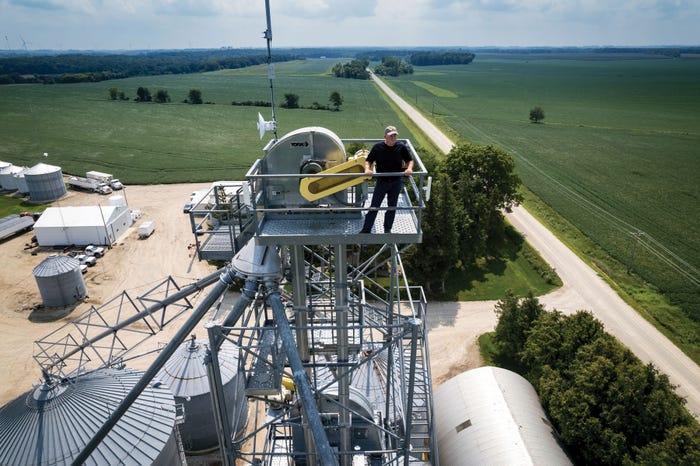
There’s no doubt that the last few years have been a wild ride. And despite rising input costs and worrisome interest rates, the overall win-lose column has favored most farmers since 2021. Relatively high commodity prices have all but guaranteed financial wins for most operations — even those who didn’t follow a disciplined marketing game plan.
That is likely to change in 2024. While some costs are down, deflated crop prices — at least in these early days of the marketing year — have some growers nervous.
“My 2024 crop budgets are going to be tight compared to this year,” says Chris Edgington, who farms near St. Ansgar in northeast Iowa. “Lower fertilizer costs won’t make up for the higher cost of money
and lower crop prices.”

“Lower fertilizer costs won’t make up for the higher cost of money and lower crop prices,” says Iowa farmer Chris Edgington. Photo credit: NCGA
Brandon Hunt has similar worries. He farms 10,000 acres near Herndon, Ky., growing corn, soybeans, wheat, tobacco and hemp. While he was happy to report corn yields over 200 bushels per acre and wheat above 100 bushels per acre, such a victory in 2023 doesn’t necessarily translate into a slam dunk for the new growing season, he says.
“I’m not over-the-top excited about 2024,” he says. “Yes, our expenses and input costs will be lower, but so are grain prices. Lower costs and lower revenue could end up a wash for profit margins. And equipment prices aren’t getting cheaper.”
All other factors being equal, sharp marketing could make the greatest impact on your bottom line next year.
Post-game analysis
David Widmar, co-founder of Agricultural Economic Insights, says anyone who is worried about how next year is going to unfold should conduct a post-game analysis at the end of each growing season. How successful was your marketing plan — or how is it doing so far if you still have unsold grain? What were your actual costs in 2023? What were your breakeven costs, and how do you think they will change next year?
“That data will feed into your 2024 plans,” Widmar says. “It will help you know what it will take to lock onto good margins.”
Widmar recommends a four-step process that will help farmers navigate these murky waters:
1. Establish goals. What are the marketing and production cost goals for your operation in 2024?
2. Activate tools. Initiate the processes that will help you achieve your goals. A solid set of tools can help, especially in grain marketing. That includes futures, options, forward contracts and hedge-to-arrive contracts. These tools can help
lock in a specific price or protect you from downside risk.
Matt Bennett, an Illinois farmer, commodity broker and co-founder of AgMarket.net, is well-aware of some of these tools and how they can mitigate risk. One strategy is to buy a put option that locks in a price and leave the upside open,
or set up an options strategy.
“You could buy a $5.20 put, sell a $4.20 put, then sell a $6 call,” he says. “That captures upside but makes the strategy cheap enough that your worst-case scenario is still a selling price of over $5 basis December corn. If you do that and the market plummets, even with the cost of the trade, you’re still at around $5 per bushel for sales.”
Likewise, Bennett has recently considered purchasing November 2024 soybean put options. That would establish an initial price floor for projected output well ahead
of the base crop insurance period in February.
Scenario planning will help you identify key uncertainties that could impact your operation. That might include changes in weather, commodity prices or even government policies. When you develop alternative scenarios based on what-ifs, you can better understand the range of potential outcomes. That allows you to evaluate the impact of each scenario, which will make you more nimble when making future decisions and help you develop strategies to respond to each scenario.
3. Review processes. Widmar suggests occasionally reviewing the processes you have put in place. The challenge to this is untangling your decisions from the actual outcomes. That’s because some quality decisions end up having bad outcomes.
“You have to disconnect the quality of the outcome from the quality of the decision you made,” Widmar says. “We have to recognize that we’re not going to make every shot that we take.”
Instead, look at bad outcomes through the lens of what you could have done differently, he adds.
4. Get feedback. The final step is to find a peer who can potentially challenge your decisions and hold you accountable, Widmar says.
That person could be a friend, family member or even a farmer-colleague from a different part of the country.
“The idea is to find someone who can be a really great resource for you to lean on and help you avoid living in an echo chamber,” he says. “Part of it also is that you have to be prepared before you go in and talk to a peer. Otherwise, you might just blindly adopt whatever they recommend.
“You want to triangulate what you’re already working on and making course adjustments. It’s all about creating a system that works for you and your operation.”
It’s a journey, not a destination, Widmar concludes.
“We’re always growing in our efforts,” he says. “We’re always changing and adapting and reacting and responding. Just because we might have had a really good process in 2015 when we had 3,000 acres and two hired employees doesn’t mean that same process will scale as our operation grows or as conditions change. We always need to be revisiting our processes.”
In other words, few processes will win consistently across a single operation as time marches on. However, with a few smart strategies put in play this winter, you can up your chances of winning in 2024.
About the Author(s)
You May Also Like








